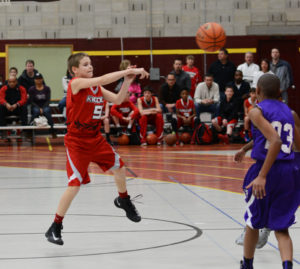10 ways to get the most from your spread zone offense
The spread zone offense picks apart zone defenses by using proper spacing, cuts and passing to maximize your team’s potential, even when playing against a much larger opponent. Follow the 10 rules listed below to get the most from this offense.
Maximizing the spread zone offense
1. Have patience. When playing against a tight zone defense, patience is critical. Otherwise, the defense dictates how you play.
 2. Utilize ball reversal. Reversing the ball is the best way to spread the defense. It allows the offense to dictate how and when it wants to score.
2. Utilize ball reversal. Reversing the ball is the best way to spread the defense. It allows the offense to dictate how and when it wants to score.
3. Read what type of zone the opponent is running and how they are rotating to the ball. Each player must know who is guarding them within the zone and how they can make the defensive player extend away from his or her rotation.
4. Players must use fake passes to shift the zone. Most zones shift to the flight of the ball. By making a quick, fake pass, this opens up gaps, which provide perimeter players the opportunity to drive into the gaps being opened. The two pass fakes we teach are lateral and to pass fake to the post.
5. Understand the gaps and how to use them. When driving the gaps at the post player, guards usually occupy two defenders. Teach your post players to read this and fade into the open area. Perimeter players use the push, pull and pitch when driving the gaps.
6. Players need to see the whole court. After flowing through the offense, the weak side of the court is open. This creates a great opportunity for a cross-court pass to set up 3-pointers and to cause more damage in the zone rotation.
» RELATED: A zone offense to beat pesky zone defenses
7. Rebounding is another big factor. Rebound in areas and compensate into other areas where you judge the ball to come off the rim.
8. Cutting also fuels the spread zone offense. There are four keys to cutting.
- When making the pass to the wing, perimeter players make a basket cut in order to cut to the open area.
- When a player has someone dribbling toward him, that player loops through the gaps or cuts to the weak side.
- After looping and making a baseline pass, the perimeter player cuts to the short corner. This causes the defense to make a decision on who to guard among the three players in the general area.
- Know about “the vacuum.” We like to sneak our weak-side guard into the middle (the vacuum) after the zone has shifted. We then exchange our top player to the weak side of the court. If the vacuum is covered, he pops to the top for the ball reversal. If the vacuum is open, he receives the pass and looks first to shoot. And if the shot is not there, he or she looks to the weak side. The weak-side player almost always is open.
9. Perimeter players must stay high and wide. The top player is situated two feet above the 3-point line. The wing players are one foot above the free-throw-line extended and two feet outside of the 3-point line.
10. Post players position themselves below the bottom defensive players and stay 2 feet from the block. Spacing is critical in the post so make sure your players know this.









